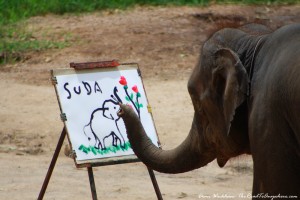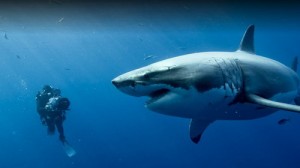We as humans have spread our influence to just about every corner of the world, regardless of the implications. The Kruger National Park in Africa is 19,633 square miles, containing 350 black and roughly 8,500 white rhinoceros. Armoured skin, a fierce horn and weighing as much as a car, a rhino is an animal you may never see in the wild unless you seek it out. The sheer size of a rhino along with it’s signature horn make it almost prehistoric, and as a result, not fully understood. The video is short in length, totalling only forty seconds. Within that short time frame we see an intruder and the resulting reaction of the rhino trying to protect itself. The car halts as a rhino appears, as it slowly moves towards the vehicle. It’s worth noting that at around :13 seconds, the rhino makes a charging gesture, as a warning of it’s intentions.
The man in the car that recorded the video seems to be both unaware, and poorly educated about rhino behavior, and attempts to calm the animal by saying “Easy! No! Easy now easy!” This attempt to get through to the animal is futile and representative of a misconception, our domesticated approach and attitude towards animals isn’t universally applicable. In more common terms, how we treat our dog and cat shouldn’t be projected upon a wild rhino. It’s a poorly understood natural world outside of our cushy lives, but it still abides to laws of nature and it’s rules. Nature preserves are examples of what I consider to be glorified zoos, due to the both the sparse human interaction, along with our evident presence. A rhino charging your car will not be stopped by a simple request, but is based on the idea of domestication and it’s consequences. The interaction in this video is short and poorly represents a false ideology of our relationship with the natural world, especially when uneducated. An unrelated but relevant point is even the format of the video attempts to label the animal as dangerous, when in reality it was responding to a threat in it’s own domain. The word CHARGES in the title is capitalized in an attempt to label the rhino as dangerous.
“The spectator’s position is circumscribed by paradox: the zoo promises it will allow them to see everything, but they really are seeing nothing.” This quote from Zoo Spectatorship demonstrates the paradox with our influence in our natural world. The idea of a zoo denies animals their defining qualities, such as a cheetah’s speed to hunt the impala, or the rhino’s horn to protect it’s family and charge through predators. We often become spectators for human enforced entertainment, following Malamud’s idea of voyeurism. Humans as spectators enforce the idea that humans are superior, along with enforcing low interaction animal relationships. Voyeurism is defined by Malamud best through the following quote, “The voyeur seeks a spectacle, the revelation of the object of his interest, that something or someone should be open to his inspection and contemplation; but no reciprocal revelation or openness is conceded” (Malamud 230). Another paradox is as follows: how do we, in a continually intertwined world, influence and remain present in nature in a mutually beneficial manner. Are we supposed to totally remove ourselves and let natural selection persist, or rather control the entire entity that is nature? Nature preserves are examples of conservative approaches towards our relationships with animals. They are human influenced, but nature focused, limiting out interaction. The focus of these preserves are to protect the biodiversity, and are non for profit. The nature focus and no profit definitely are better than a zoo, but still raise moral issues.
Many of these thoughts draw from a similar starting question, are we able to have genuine, and mutually recognized interactions with wild animals, and if so, why? Malamud raises the issue of animals and their media portrayals, which aid in developing a poor identity for wild animals. He argues that media often uses animals due to their inherent relatability, and our perceived mutual interaction. Drawing off a previous point, the title of this video is capitalized and formatted in such a way to draw our attention, but it demonstrates a stupid human overstepping his boundaries. The truth is, the rhino clearly was both defending itself from a foreign object, along with protecting it’s home regardless of the title of the video. This video raises a final issue at the end with the slogan, SHOOT, SHARE, SELL. This simple alliteration forces the animal into being a commodity, a forced instrumental view, which neglects looking at the rhino through an intrinsic lens.
Works Cited:
Malamud, Randy. Zoo Spectatorship. New York: New York University Press, 1998. Print.


Recent Comments